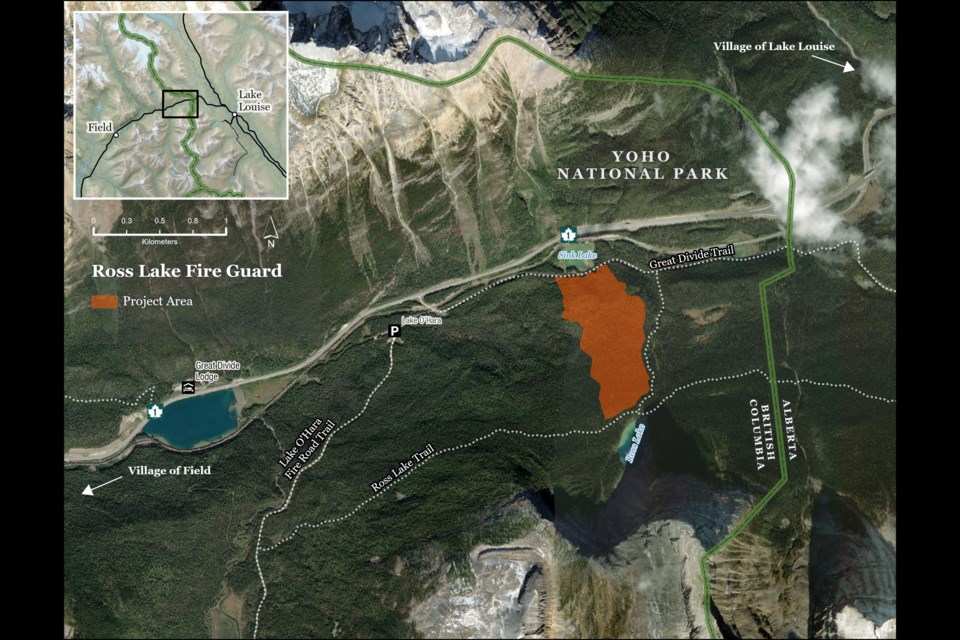YOHO NATIONAL PARK – Parks Canada is creating a massive fireguard to protect Bow Valley communities and the village of Field from a future wildfire given the dense forest is prime to burn under the right conditions.
The 49-hectare fireguard, about one kilometre long and 400 to 500 metres wide, will be heavily logged east of Lake O’Hara Road and northwest of Lake Louise, spanning from Ross Lake to Sink Lake along Highway 1A in Yoho National Park over winter, beginning in November.
Fire experts say the containment line will help reduce the intensity and rate of spread of wildfires along the Kicking Horse Valley corridor and provide a safer area to fight forest fires on the ground.
“If we had a large fire in Yoho park, it would significantly reduce the potential for it getting into the Bow Valley,” said Charlie McLellan, fire and vegetation specialist for Lake Louise, Yoho and Kootenay.
“But on the flip side, also if we had a large fire in the Lake Louise region or even the Upper Bow Valley, it would reduce the threat of it getting down in towards the town of Field.”
Earlier this year, Parks Canada finished up logging a large swath of land to create a 33-hectare fireguard near Protection Mountain in Banff National Park to help fight future wildfires threatening Lake Louise and surrounding areas.
While projects like Ross Lake and Protection Mountain are planned in advance and subject to environmental assessments, an emergency fireguard had to be bulldozed in Kootenay National Park in 2003 when the lightning-sparked Tokumm-Verendrye fire threatened the Bow Valley.
This year marks the 20th anniversary of the Tokumm-Verendrye fire, which ended up scorching 13 per cent of the park and came dangerously close to burning down the 100-year-old Kootenay Park Lodge.
The fire, dubbed the “Holy Shit” fire, doubled in size on Aug. 20, 2003, in a matter of hours and headed for the Bow Valley.
However, McLellan said the intense fire never advanced beyond Vermilion Pass because of the two kilometre-wide fireguard near Stanley Glacier.
“The difference is this one at Ross Lake is being done proactively, so not during a wildfire, which is beneficial for a number of reasons,” he said.
“We can mitigate the impacts more and and we're not racing the clock per se, because we don't have a fire actively burning.”
Bow Valley Naturalists has voiced support for landscape level fireguards, but with caveats.
“After what seems to be another summer of endless western wildfires and smoke, it’s hard to argue that these aren’t needed,” said Reg Bunyan, past president of Bow Valley Naturalists.
“However, it would be naive to think that these landscape level fireguards are a standalone solution.”
While logging and thinning reduces fuel loads, Bunyan said it does not duplicate the renewal process that accompanies fire.
He said prescribed fires much more closely match ecological processes and should be incorporated into these landscape level fireguards where feasible.
In addition, Bunyan said it’s important to not forget about the importance of FireSmart practices within urban areas.
“Most of of us chose to live in the Bow Valley because of outdoor access and nature connections,” said Bunyan.
“Paving and logging paradise may make us feel safer, but ultimately, short of clear-cutting and paving the park, that choice entails living with a certain level of risk exposure to natural events, including fire.”
A changing climate means longer and hotter fire seasons, and combined with more than a century of fire suppression in the mountain national parks, this has led to tinder dry and aging forests that have created perfect conditions for high intensity wildfires to spread quickly.
“The science has been projecting these fire seasons to become longer, drier, with larger fires,” said McLellan.
“Certainly this summer across Canada, we’ve seen that in a lot of different locations, not just in the west, but obviously up in the boreal forest and in Quebec as well.”
This year, Canada has experienced its worst wildfire season on record. An estimated 15 million hectares have burned across the country, breaking the previous record of 7.6 million hectares in 1989 and more than six times the 10-year average of 2.5 million hectares.
With out-of-control fires from coast to coast, tens and tens of thousands of people were forced to flee from their homes during this unprecedented fire season, which fire and climate experts say is still far from over in some parts of the country.
McLellan said this wildfire season emphasizes the need for these type of proactive projects such as the Ross Lake fireguard.
“If we get a large fire in and around these locations we will have measures in place that make managing them a lot easier so we can keep them at a smaller size,” he said.
“Smaller fires have less impacts, less smoke and air quality issues, as well as require less resourcing, which became challenging this year when there were so many fires.”
McLellan said there hasn’t been a large fire in that region since the Canadian Pacific Railway was under construction in the 1880s.
But he said a a history of fire suppression in the Kicking Horse Valley has created dense forests, susceptible to insect and disease outbreaks and prone to high intensity wildfires.
“Based on our natural fire cycles, or fire return intervals, it is certainly at that point that you would expect it to naturally burn again,” said McLellan.
Parks Canada has opened up bids for the Ross Lake fireguard project, with a deadline of Oct. 2.



